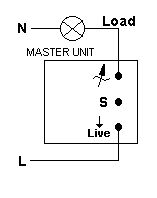- Joined
- 5 Nov 2010
- Messages
- 379
- Reaction score
- 3
- Country

I'm installing a new light switch and I'm trying to get my head round which connector is used for power coming in and which is going out to the light itself.

Judging by this illustration, the load connection is one going out to the light. Is that right or have I just killed myself?
BTW, I know the S is used for the slave switch but I'm not using one.
Thanks and hope you can help.
Judging by this illustration, the load connection is one going out to the light. Is that right or have I just killed myself?
BTW, I know the S is used for the slave switch but I'm not using one.
Thanks and hope you can help.

